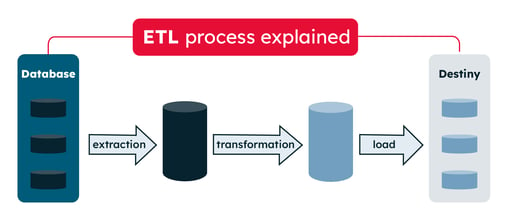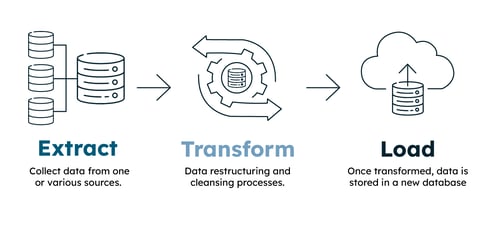Discover why ETL is your Business Intelligence’s core strategy
You surely have questions about your business strategy: you may have wondered if it’s solid, if your company’s generated data is really useful, or maybe you're afraid of the advantages competition may have through confidential processes you would like to be in the know of. In this article you’ll discover that answers to these questions are in front of you: you’ll learn why ETL is the key for a good Business Intelligence in order to keep your company at the forefront by discovering the real value of the information it produces.
ETL definition
There is a great variety of processes which involve moving, modifying and transforming data but, particularly, ETL enables using holistic techniques to get the most of your business information.
ETL means extract, transform and load, and it refers to any type of process done to data involving those terms; they’re usually performed to move, migrate and analyze data from different sources and to store it in any database for a good use.
This process is the main source of information regarding the state of any business’ development, since it is the preview of a broadened overview of movements done, acquisition and retention of new clients, improvement or worsening of sales, staff turnover and its possible causes, among other business management data. It also provides knowledge about movement tendencies and predictions, thus facilitating good decision making.
ETL meaning.
Key ETL process steps
First step: data extraction
The information stored in one or various databases (as the term indicates) is extracted from its origin; during this stage, data must be homogenized in a single structure since it tends to have different formats while being stored in different places, which ends up being a difficulty to achieve good data integrity (explained further). This first structuring phase takes place in specific platforms by using algorithms as well as specialized pipelines which take said information and analyze it to determine its origin in order to modify it and achieve its unification.
Another essential step during this process is to identify data volume to determine what type of extraction will be needed: if it’s either incremental or full extraction.
- Incremental. This extraction allows one to obtain the most recent data from an original source in order to transform it and load it in a new place according to company’s needs.
- Full. Allows full extraction of data from the original source to replace what exists in the final destination.
The most important thing to consider when extracting is to intervene as little as possible in everyday business processes, therefore, extractions are usually carried out during hours of little to no activity in the initial source.
Second step: transforming data.
Once the information is extracted and homogenized, a cleaning, ordering and deep restructuring stage is reached to modify data as needed: formats and values are changed according to objectives. There are four types of transformations:
- Constructive: it adds, copies and replicates data.
- Destructive: it involves deleting fields and registers.
- Aesthetic: it estantarizes formats.
- Structural: it renames, moves and combines columns inside the database.
These transformations can be performed within an ETL tool or can be carried out by teams of data scientists, data engineers, and data analysts using languages such as Python or SQL.
Before any transformation, it is important to define some business guidelines for data modification, which can be:
- Declarative
- Independent
- Clear
- Intangible
- With an end for the business.
Some examples of transformations are:
- Translate and modify code to unify terms such as W for woman and M for man: they can be modified to be F for female and M for male, depending on what is needed.
- Unify multiple related data.
- Divide columns of information.
- Only choosing the columns needed for loading.
Third step: data load.
Once data is transformed according to its future use, it will be transferred to a new destiny, which can be a database, a data mart or data warehouse previously defined to make the most out of it. There are two ways of loading data:
- Simple accumulation. The transformations are summarized and all data gets sent in a single movement, keeping a record of this process’ magnitude.
- Rolling. To maintain granularity, it is necessary to order the information at different hierarchical levels. For example: daily, weekly, monthly totals, etc.

ETL process.
Implementing an ETL process can be quite complex if the system is poorly designed: this can result in serious operational problems. To prevent your data from losing its integrity, at Arkon Data we have a team of data scientists and data engineers who can advise you on how to develop a process like these with our easy-to-use platform.
ETL Current context
It is super common to underestimate this process as just another tool within Data Management that only organizes information. In the last year, we’ve seen its evolution by becoming essential in the development of data integration. In general, this refers to data profiling, data quality, data operational processes, transformation services (CDC, SCD, etc.), real-time access, metadata management, among others.
A good data integration allows creating a complete and profound outlook about a business's current state: ETL can boost any organization’s development.
Advantages of applying an ETL process
One of the most common dilemmas inside businesses is how to save money and time. Companies usually carry out their movements and coding manually, but, by implementing an ETL, many processes are automated, thus reducing execution times and costs by doing so. Other advantages include:
- Consolidation of a Master Data Management (MDM). This process makes it possible to automatically and accurately identify essential data for the company.
- Better decision making. Thanks to insights provided by this process, you can guide your business towards specific objectives by having a great perspective with historical data.
- It’s the next step towards Business Intelligence (BI). By having great data management, you’ll be able to integrate all of your business processes for it to become data-driven inside a business intelligence environment.
How is ETL a part of Business Intelligence
The term business intelligence was previously used to define the exchange of information between organizations. This meaning evolved to signify the use of computing models for better decision making.
Business Intelligence is a series of practices and ideas within Business Management that looks for the use of data as pieces of value to obtain insights from it.
It involves data extraction from different sources, transforming it for query, reporting, analysis, and uploading it to a centralized data warehouse or other repository.
There are different processes within Business Intelligence, some of them are:
- Data mining. It is active search and deep analysis of data through statistics and machine learning to discover tendencies.
- Report generation. As the name says, data reports are created to reach good decision making.
- Benchmarks, metrics and performance. Using historical data, performance is tracked and benchmarks along metrics are drawn to measure goal achievement.
- Data preparation. When you compile data, it is analyzed for preparation and for its next analysis or transformation.
In some way, the previous processes can be an extension of an extraction, transformation and/or loading process. An ETL process is at the core of Business Intelligence systems, since it helps to create predictions about future trends, marketing dynamics, variations between supply and demand, among other variables which are of great importance for BI: ETL is essential to gain a consolidated view of data which drives the practice of making better and more informed decisions.
Relation between ETL with BI.
Benefits of ETL BI
There are plenty of businesses that overlook having a data intelligence strategy based on ETL; these organizations usually have unstructured information with no consideration for the benefits optimized information brings. By applying a well founded business intelligence by using ETL, you will be able to achieve the following:
- Higher efficiency of your business to discover market needs and desires of your clients.
- Higher competitiveness by being up to date with trends through understanding market movements. By introducing BI to your organization, you'll be able to stay ahead of trends and track changes to predict your customers' next needs.
- Create reports efficiently through BI, which enables faster data analysis through automated processes, resulting in significant time savings.
- Ensure your company’s development due to the broad panorama that this tool offers by knowing your data’s real value, by learning about it and being able to generate predictions about the found trends.
Now that you have a bigger picture of how important these tools are, we can conclude by saying that:
- ETL is an essential tool to achieve good data integrity.
- Data transformation benefits business management processes.
- Business Intelligence is a series of processes which lead to discovery of your data’s true value.
- ETL is the core of business intelligence systems.
At Arkon Data we have a complete team of data scientists and data engineers who analyze and find the best solutions for managing your business processes and data flows, all with the implementation of algorithms and advanced analytics. Through our platform, you’ll be able to create BPMN diagrams with an easy-to-use inteface. You’ll achieve a good business intelligence strategy with us by using ETL and data integration.
.jpg)
Ana Lucía Gutiérrez Tapia
Ana Gutiérrez is a passionate copywriter and content creator at Arkon Data. When she is not diving into data-related themes like ETL, data management, cloud migration, Data Governance, and Business Intelligence (among many others), you can find her illustrating her nightmares and singing metal and classical music while petting her cat.






